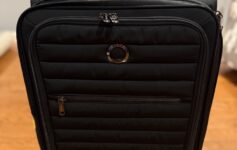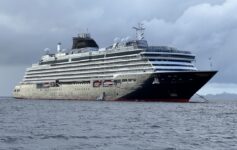An innovative darling of the design-focused direct-to-consumer business was Away. But now, it’s lost its way and is rumored to be up for sale.
If you are considering booking travel or signing up for a new credit card please click here. Both support LiveAndLetsFly.com.
If you haven’t followed us on Facebook or Instagram, add us today.
Away, the once-celebrated luggage startup, has found itself entangled in a web of controversies and financial challenges. Initially praised for its innovative products and direct-to-consumer model, the company is now facing potential changes in ownership. Amidst internal strife and a declining growth rate, rumors of a sale are surfacing, raising questions about the future of this travel accessory giant.
The Rise of Away
Founded in 2015 by Jen Rubio and Steph Korey, Away quickly became a household name among travelers. The brand’s flagship product, the Carry-On (bag), was lauded for its sleek design, durability, and built-in battery pack. I reviewed it early on. Away’s aggressive social media marketing and pre-order strategy helped the company achieve rapid growth, amassing over $12 million in its first year and reaching profitability by the end of 2017. It expanded into checked bags, aluminum pieces, and soft-sided backpacks. The company timed its launch right as baggage fee increases forced more travelers into utilizing overhead bins over checking luggage into the hold.
What made Away so successful was that it felt premium but was still attainable. It was simple – everything you wanted (zipped nylon interior section, durable exterior, uncomplicated simple design, TSA locks, omni-directional wheels) and then something you never knew you wanted – an integrated battery pack. It operated in a market mid-point of good design in the premium space without tipping into luxury competitors.
Away offered a reasonable designer piece that resonated with a new era of professional travelers.

Internal Struggles and Public Backlash
Away’s meteoric rise was marred by a series of scandals that exposed a toxic workplace culture. In late 2019, an exposé by The Verge detailed allegations of demanding and abusive management practices under co-founder Steph Korey. Employees reported being subjected to long hours, minimal paid time off, and harsh reprimands for not responding to messages promptly, even outside of work hours. This led to significant public backlash and a temporary resignation by Korey, although she later returned as co-CEObefore departing again.
Financial Performance Amidst Controversy
Despite the negative press, Away’s sales figures showed resilience. Data from Second Measure indicated that Away’s U.S. sales in December 2019 were 20% higher than the previous year, even after the exposé. However, this growth was part of a broader trend of slowing year-over-year increases, reflecting the challenges of maintaining rapid expansion as a startup scales .
Leadership Changes and Strategic Shifts
In response to the mounting issues, Away appointed Stuart Haselden, a former Lululemon executive, as co-CEO. The leadership reshuffle was intended to stabilize the company and address its cultural problems. Yet, Korey’s return and subsequent social media outbursts only added to the turmoil. By mid-2020, Korey announced her permanent departure, leaving Haselden to steer the company through the pandemic and beyond.
Part of the issue is that management, and the market funded the business as if it were a tech startup. For example, after a fundraising round, a company that had just $150MM in sales was valued at $700MM. Later, it would rise to nearly a billion and a half on $300MM in sales. Many tech startups have an approach in which they worry less about the actual profit and loss of the business and more about the potential. But it’s not a tech company at all, it’s a luggage company and the cost of sales for a $150MM in revenue is high and margins were low.
The Prospect of a Sale
As Away continues to navigate these turbulent waters, rumors of a potential sale are gaining traction. Mentioned in February of 2024, some say that now there’s even more pressure to find a buyer. Industry insiders suggest that the company’s valuation could be significantly lower than its peak, making it an attractive acquisition target for larger players in the travel and retail sectors. The prospect of new ownership could bring much-needed stability and a fresh strategic direction to Away.
Alternatives to Away: Emerging Contenders in the Luggage Market
As Away’s future remains uncertain, several other luggage brands are stepping up to fill the void. These brands offer well-designed, affordable options that have the potential to become the next big thing in the travel industry.
1. Monos
Monos is often compared to Away for its sleek, minimalist design and high-quality materials. Their luggage features a durable polycarbonate shell, quiet wheels, and a vegan leather handle. Priced similarly to Away, Monos has gained a loyal following for its attention to detail and lifetime warranty.
2. Quince
Quince’s luggage offerings include high-quality, minimalist suitcases and travel bags designed for durability and style. Made from premium materials such as lightweight polycarbonate and water-resistant nylon, their luggage is built to withstand the rigors of travel while maintaining a sleek, modern aesthetic. The appeal lies in Quince’s commitment to offering luxury-level products at a fraction of the typical cost, with a focus on functionality, sustainability, and transparent pricing. Travelers appreciate the combination of affordability, durability, and chic design, making Quince luggage a smart choice for discerning consumers.
3. Paravel
Paravel distinguishes itself with its commitment to sustainability. Their Aviator Carry-On is made from recycled materials, including a polycarbonate shell and aluminum handle. With features like frictionless wheels and interior compression boards, Paravel offers both style and substance. The brand’s eco-friendly approach appeals to environmentally conscious consumers.
Conclusion
Away’s journey from a disruptive startup to a company in crisis highlights the challenges of rapid growth and the importance of sustainable business practices. As the company grapples with internal and external pressures, the possibility of a sale looms large. For Away, new ownership could signal a return to its innovative roots and a renewed focus on delivering high-quality travel products. Meanwhile, emerging brands like Monos, Quince, and Paravel are well-positioned to capture the attention of travelers seeking stylish, functional, and affordable luggage. The industry will be watching closely to see how these contenders shape the future of travel accessories.
What do you think?




Any company which cannot behave civilly towards it’s employees , is trash for the dumpster .
Do you think calling it a company in crisis might be a bit overstated? The fact that the VC community put an abusrd valuation on the business makes it one of hundreds to have gone through the same experience. You neglected to point out the role the near-zero interest rates and the stimulus fueled consumer economy led to companies like this seeing meteoric revenue increases (and inflation).
I have a few Away bags that I rarely use (although other family members do). They always struck me as cheap and plastic. But, I accept that many love them.
Long story short…a toxic CEO was eventually canned. The only thing that makes this remotely unique in business (particularly in start-ups) is that she happens to be female.
They may have compressed margins. Their growth may be slower than it was. They are almost certainly worth less than they were at their peak. However, they’ve built a hell of a business and brand in less than 10 years.
No one needs these overpriced brands. The industry leaders have been around forever for a reason. I doubt anyone is going to be impressed that you have a Monos bag and will be begging to sleep with you.
Idiots and their money are always separated quickly. And it’s why we see people that made $200k a year for decades still working at 55-60 looking miserable on their laptops flying.
As for Steph, it’s nice to see a hard working woman who demanded more from her employees. Of course they cried about it instead of moving on to work at a place that let me the lazy slugs they are. Crybabies.
“… nice to see a hard working woman who demanded more from her employees .” …
And how , exactly , would @Dave handle her ? What would @Dave have done to alleviate her lack of manners ?
I would never purchase a piece of their luggage knowing this now.
No wonder they lost the united amenity bag.
No yelling screaming or treating poorly….to hell with them
They can get lost together with their idiot funders. The only new-age luggage brand that has any appeal to me is Horizn Studios (helpfully omitted from this article), but I am not convinced that it’s worth paying a premium to buy the prodover the Delsey/Samsonite alternatives.
Duplicate, please delete
They can get lost together with their idiot funders. The only new-age luggage brand that has any appeal to me is Horizn Studios (helpfully omitted from this article), but I am not convinced that it’s worth paying a premium to buy their products instead of the Delsey/Samsonite alternatives.
How much did they pay for this?
A few free bags?
My Costco Samsonite is still going strong after over 100 segments across 4 continents.
All of this for half the price. Talk about affordable.
Now don’t get me wrong. I think their bags have good design but way overpriced. If you buy this, go buy Rimowa better. At least you get what you pay for.
If people care about company leadership behaviors and impact decision over it’s product. You should renounce your citizenship.
I never understood the appeal of Away bags even though they were plastered and promoted all over social media. I am on my 2nd TravelPro carry on with magnetic wheels (prefer that it has pockets on the outside) and was very happy with both.
Now that you mention it, the fact that they’re plastered all over social media is probably a good reason to be wary of them. I’m sure I have previously mentioned my lousy experience with a Thule suitcase that came with a comical RRP tag (I think it was at least €500) and seemed a bargain when reduced to £200 or so but came apart after two trips.
It had an unusual (relative to Thule’s tiny market share) amount of ‘unbiased’ glowing reviews on blogs and other ‘influencer’ pages. On reflection, I should have spotted that the reviewers obviously weren’t the sort of travellers who would drag a case a mile from the ferry port to their hotel in Cabo Verde or take advantage of married segment award availability and check it through on a mixed-class LHR-BRU-MAD-BOG-CTG itinerary. I’m sure it would have fared much better if I only ever travelled by car/taxi.
I only have an Away international carry-on because I basically got it for $40 after the Amex green card signup bonus and credit a few years ago. It is definitely worth what I paid, but not ~$300 they are charging now. I am very happy I some VC’s some $$ while I could.
Nothing pushed on instagram is ever worth what someone pays for it. If you see something you like there, search for something similar on Amazon where you’ll get the exact same thing made by the exact same manufacturer for what it’s really worth.
Show me a single company being pushed by influencers that is making their products domestically.
MrBeast burger.
Showed you.
Quite a few smaller companies market themselves heavily on Instagram etc, including whose very business model/competitive advantage is making things locally. I sometimes purchase clothes from people like+351, ISTO (Portugal), Capitán Denim and Brava Fabrics (Spain) and they are very keen on engaging on social media and emphasising local production, transparent supply chains etc. Of course these people don’t have VC backing, so I am not expecting to see them getting endorsed by Shakira, Cristiano Ronaldo, or even Christine Lagarde.
Hmmm “Away quickly became a household name among travelers.”
I’d never heard of em until last week while watching streaming with my wife and a cheesy low-budget commercial came on for them. Neither my wife or I had ever heard of em. We’ve been to 6 continents since then, I spend 25-30% of the year out of town, and I read boarding area every year but, sure, I guess they’re a household name among travelers.
My first impressions seeing their commercials is that they’re trash. Reading their history in this article and the comments here that’s also my second and third impression also.